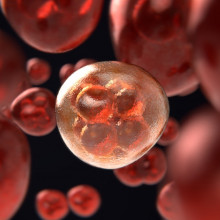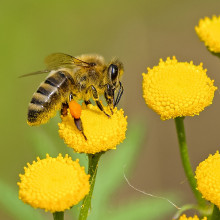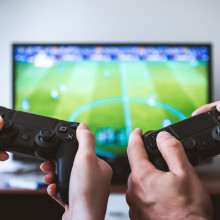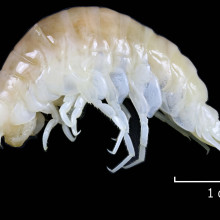Charged up bees and deep, dark seas
In the news this week, a new health study of unprecedented scale launches in the UK to improve disease detection, CAR-T therapy is administered without tailoring it specifically to the patient, the shock experienced by the scientist studying buzzing bees, computer games show signs of improving cognition in youngsters, and we delve deep into the ocean for signs of evolution happening before our eyes...
In this episode

00:52 - New health study enlists 5 million Brits
New health study enlists 5 million Brits
Raghib Ali, Our Future Health
First up this week, a new health initiative has launched in the UK which goes by the name Our Future Health. It’s a government-funded study that’s aiming to find earlier signs to better detect diseases and will initially enlist up to 5 million Brits. Raghib Ali is the Chief Medical Officer on the project…
Raghib - In some ways, this is a study I've been waiting for 25 years for, since I was a student. One of the things I noticed when I first started seeing patients as all of us do as doctors, is that many of our patients present with diseases that are largely preventable, or at least able to de delayed. Whether it's diabetes, heart disease, many cancers. Through the course of my career, I've seen too many patients - I work in A&E as a consultant - if we'd been able to check that disease earlier, we would've been able to prevent or at least delay it to much later in life. Our Future Health has been established to understand how we can better prevent disease by identifying people who are at high risk earlier and then intervening earlier to prevent those diseases. Tools and diagnostic tests have improved significantly over the last 10 to 15 years that now give us the opportunity to do that.
James - One of the most eye catching things about this study is just how big it is.
Raghib - You are right, it is unprecedented in its scale and ambition. But we really do need around 5 million people because for the first time, what we're doing with this study is making it open to everybody, all adults in the UK, 18 plus. Not all diseases are as common as as others, and so we want to be able to study every disease, every common chronic disease in every group of people. And that's why we need 5 million people. But you're right, it's a big challenge. And what we're trying to do over the course of the next few years is to make it as easy as possible for people to take part. So most of what that that involves is done online. People can sign up online, fill in a questionnaire online, book an appointment online, and then attend one of our centres to give blood and physical measurements.
James - Are you able to give some specific examples of exactly the sort of research and eventually treatments which will benefit from the use of the data collected in this study?
Raghib - There are some diseases, including most of the common chronic diseases, that have a genetic component to them. So although it's often our habits, diet, lifestyle, physical activity, tobacco, alcohol, etc., which are modifiable risk factors, whether you develop a disease or not is often linked to your genetic background and makeup as well. And so what we're able to do now is to identify those who are at higher genetic risk and they can be put into screening services at an earlier age. And that means instead of just going by age alone, you've got a more risk based assessment for screenings that will help us also detect cancer using circulating tumour cells within the blood. It's really detecting disease at an earlier stage because most diseases develop over years or even decades and up until now we haven't had the technology to detect them at the earlier stage. But now that's what we're trying to do. And also to develop treatments based on the data that we're collecting to intervene earlier. Sometimes that will be behavioural change, but it could also be new pharmaceuticals, new drugs that we can use.

04:09 - Off-the-peg anti-cancer cell treatment
Off-the-peg anti-cancer cell treatment
Waseem Qasim, UCL Great Ormond Street Institute of Child Health
In recent years, doctors have begun to treat cancers of the blood, called leukaemias, by reprogramming some of a patient's own white blood cells to target their own cancer. This is called CAR-T cell therapy. It's very effective, but the problem is that it's also very expensive, because it has to be done on an individual patient basis. It also takes a lot of time, delaying treatment. Much more effective would be to engineer cells that anyone could use. And this week researchers at UCL's Institute of Child Health in Gt Ormond Street, London, have announced that they've done just that. They've engineered white blood cells that have been disarmed and cloaked so they don't attack healthy tissue, or get taken down by a person's own immune system, and instead they go after exclusively leukaemia cells. And because they are ready to go immediately, there are no treatment delays. Waseem Qasim has now treated 6 children this way....
Waseem - There are certain types of blood cancer leukaemias that are now treatable by using the power of the immune system that can be reprogrammed. So they go around the body and clear up leukaemia that's otherwise resistant to chemotherapy or has come back after chemotherapy.
Chris - How do you actually reprogram an immune cell?
Waseem - Well, we take the white blood cells, they're taken to a laboratory and while they're there we use a disabled virus to add a chunk of DNA which programs for a new, think of it as an arming device, that can then recognize and target the cells towards abnormal cancer cells. Usually they're then frozen and undergo a round of quite stringent tests before they're returned to the hospital where the patient receives them as an infusion. And then it's the question of waiting for a period of days or weeks to see if the cells are going to manage to clean up the leukaemia.
Chris - What have you done to improve on this then?
Waseem - At the moment, these are patient-bespoke therapies and what we've tried to do is make them available off the peg, if you like, or off the shelf. So to do that we have to add in some extra engineering steps, which means that they can be infused into multiple recipients without the need for very close matching.
Chris - You're saying you're going to make available to anybody, cells that have been manipulated in this way to go after cancer. So it doesn't matter who they are, they can have these white blood cells and anyone can use them. So how do you stop them being recognized as foreign when they go into the cancer victim's body and how do you also stop them attacking things they shouldn't?
Waseem - Yes, that's two very important questions. So if I deal with the second one first, we can disarm the cells by removing their own T-cell receptor, which is their normal arming device. It's the normal weapons they carry on their surface to attack viruses and so on. So we take those away and then we reprogram the cells so they only recognize a single target, and at the same time we remove one of the flags of the surface of the cells that will make them invisible to one of the chemotherapy antibodies we use to subdue a patient's immune system before the cells are actually given. So all of that together means the cells will have a free run for two to three weeks after infusion in a patient without really being challenged by the patient's own immune system. And we think that's actually long enough to get a deep clearance of leukaemia.
Chris - And does it work?
Waseem - Well, we treated six children out of which four successfully reached a stage of remission, by which we mean within 28 days we couldn't detect leukaemia anymore. Now, over a longer period of time, two of those patients are still clear of leukaemia. The furthest one out is well over a year out now. Now, unfortunately, in a couple of the others, the disease did eventually come back. So we're looking at why that happens and how it manages to evade or escape the effects of cells over a longer period of time.
Chris - How would that outcome compare with what we consider a gold standard practice - not doing your new approach?
Waseem - Generally speaking, we think the longer term outcomes won't be far off those achieved by patients receiving their own cells. Bearing in mind at the moment where only treating the patients that have not been able to have the treatment from their own cells for various reasons. And so they tend to be the more advanced patients that are coming for these type of trials. I think it'll take a longer period of time to work out what the comparisons will be. Then ultimately you'd have to run a comparison study with two groups of very similar patients to find out what the actual overall rates are.

09:42 - Bee swarms create massive electrical charge
Bee swarms create massive electrical charge
Sam England, University of Bristol
Bees are well known to create a buzz when they fly, but scientists were shocked to register an electrical charge build-up on swarming bees on par with a thunder cloud, as Will Tingle heard from Bristol University’s Sam England…
Sam - In our lab, we're really interested in the ways that, you know, animals and plants use this naturally occurring electricity that kind of exists all around us in their lives. So we are often both doing experiments or taking measurements with animals such as honeybees, but we also want to get a nice background measurement of the kind of naturally occurring electricity that's just in the atmosphere all the time. And one day we were doing some of these background recordings and it just so happened that one of our honeybee hives decided to swarm, which is when the queen of the hive, she flies away and makes a new nest somewhere else. And it just so happened that we captured this on our electric field sensor. We saw this massive spike. Obviously it wasn't the most controlled experiment ever, so that kind of told us that we should keep an eye out for next time. If there's going to be another honeybee swarm, we should be a bit more prepared with all of the recording equipment ready, all of the cameras to film the whole thing. So it was a bit of a happy accident really. But sometimes the funnest science works out that way. The main finding of our study is actually that it's pretty remarkably high. When these bees are on their own, we already know that they do carry a small amount of electric charge and this actually helps them do things like pollination. For example, It allows pollen to jump from a flower onto a bee without any contact even being made. So we already knew that there was some small amount of charge on individual bees, but we've never measured an entire swarm. And it turns out when you measure a swarm, unsurprisingly, there's a lot more charge going on. And so at ground level where we made our measurements, the strength of this electric field is really comparable to the kinds of changes in electric field you see during thunderstorms.
Will - And as we search for renewable sources of energy, though, I'm assuming it wasn't enough to hook these bees up to a dynamo and maybe power our kettle.
Sam - I mean, you could definitely get something out of it. I don't know about a kettle but you could maybe power like a very low power LED or something like that, perhaps.
Will - That's fair enough. What do you think causes these bees to generate this charge?
Sam - This is something that we're kind of trying to figure out and have been trying to figure out for quite a while. There's two main mechanisms that we think are probably behind it. The first one is something called triboelectricity, which is basically a really fancy word for friction, right? In the same way when you rub a balloon against your hair, the balloon becomes charged, your hair becomes charged, and you can move your hair around with it. We're thinking that maybe that's something that's going on. So as they fly through the air and their wings and body make friction with the air, but also with the body of the bee itself, that this charges them up. But we also think that possibly as they're flying around, they're also scavenging ions, so charged particles that are floating around in the air all the time, that they're kind of being focused onto the bee in that way. But the honest answer is that we really don't know.
Will - To postulate for a second, as you say, this is in the early stages of its development, but do you think that this electrical charge generation is only unique to bees? For instance, we have these large swarms of locusts. Would they be, do you think, generating the same sort of thing?
Sam - Yeah, I think definitely. So we've actually measured quite a lot of different insects including some, some locusts actually. And it's generally true that most insects tend to build up at least some amount of positive electric charge. So it's possible that it's quite a widespread phenomenon. What makes it really interesting with bees and locusts is that they do form these very big swarms and so their kind of collective charge can become very large.
Will - Obviously we want to look after our insects. It's important to know where they are in what numbers they're in. So if we know that they are generating electrical charge, do we have sensors that could potentially map or track our insects to better find out their distribution, maybe help preserve them a bit better?
Sam - With the honeybee swarms, it's likely that their effect on the electric field around them is going to be relatively local. So we're kind of talking within a few meters of where the swarm is. But locus swarms, for example, are much bigger and tracking them is also important because they cause huge agricultural damage. And I think there is definitely a possibility that the kinds of sensors that we've already used in our study and that other people are using to record thunderstorm activity could be repurposed for tracking locust swarms. We've really neglected the influence of naturally occurring electricity in our understanding of the lives of animals and plants and I think this provides a really nice example of that, but I think there's so much more to be discovered, because electricity really is everywhere. It's not a man made thing. You know, it's been around since before life was on earth. And so it kind of makes sense that a lot of animals and plants and other organisms would be exploiting it in some way.

14:43 - Video games improve children's reaction time
Video games improve children's reaction time
Bader Charaani, University of Vermont
Video gaming is big business. The industry turns over more money than Hollywood, and stats show that about three quarters of youngsters are regular gamers. Nevertheless, some, including parents and educators, say they're concerned about the knock-on effects of gaming on children's development. There's also an alarming rise in childhood obesity associated with low levels of physical activity in this age group. Putting this latter, albeit very important issue, to one side and considering just the cognitive side of things though, according to a study just out from Bader Charaani, at the University of Vermont, avid gaming does appear to be boosting some aspects of brain power…
Bader - As a hardcore video gamer, I was naturally interested in looking at any relationship that video game may have with mental health, behavior, or cognition. And if you look at the literature about video gaming, the majority of studies are negative outcomes such as relationships between video gaming and depression, anxiety, aggressive behavior. So I wanted to verify, because I have access to a large database called the ABCD Study. We have 2000 subjects in total, kids who never played video games and kids who played video games.
Chris - What exactly is the data you've collected? How have you collected all this and what questions are you asking?
Bader - So the ABCD study started in 2015 or 16. It collects data on 12,000 kids. We track them since they are nine and ten years old through adolescents and into young adulthood. And every two years we do a follow up assessment. The data we collected includes behavioral data, substance use data, neuroimaging data, genetic data. And the goal is just to better understand the neurodevelopment and the behavior in children and adolescents.
Chris - And included in that is history taking about use of video games presumably?
Bader - Yeah, so it also includes a large battery of questionnaires. So the video gaming questionnaire is part of a larger screen time questionnaire that asks kids how many hours they spent on consoles or playing mobile phone or any other device.
Chris - Obviously this is self-reported data, but I presume what you then did is to say, I know roughly how long these individuals are spending playing games and I've got these other metrics including behavioral data and crucially brain scans. And I can now marry up and ask are there differences in the people who have a greater exposure to computer games compared to those who have a lesser exposure?
Bader - Yeah, exactly. We compared performance when the kids performed two tasks inside the MRI scanner. These probe impulse control and working memory between video gamers and non video gamers.
Chris - And when you do that, how do the kids that are avid gamers, like you work or are, compare with the kids that never go near a computer?
Bader - So we have seen significant improvements on two tasks in terms of faster reaction time and video gamers, better performance in terms of impulse control, and also better performance in tasks involving working memory accompanied by changes in brain function and regions of the brain involved in vision, attention, problem solving and memory processing.
Chris - Do you think though that the way you would've done this in the brain scanner was to give the kids an environment to look at that's pretty similar to a computer game and therefore it's unsurprising their brain gets more activated because they're used to doing that if they play lots of computer games? Because it's almost like they're in their comfort zone compared to children who don't do that as much. Is this a real extrapolable finding to the real world, do you think?
Bader - That's a great comment and actually one of the comments by the reviewers of the paper. To address that comment, we looked at tasks performed out of the scanner that do not involve any visual stimulus. So we use task working memory tasks that are done verbally and orally like language. And we saw that video gamers still outperform non-video gamers.
Chris - And do you think you are really comparing apples with apples? Is it that children who don't play video games don't play them for a reason? They have some other reason not to, and therefore you're not really comparing children who are otherwise comparable who do and don't play computer games and that could account for why their brain activity is different?
Bader - That's a really good question. So fortunately the ABCD data set is large enough to allow us to control for a large variety of confounding variables. Sex, socioeconomic status site, geographic location. We can also control for mental health scores. So to answer your question, yeah, we are pretty confident to compare apples with apples.
Chris - Why do you think the kids are showing these brain changes? What's the gaming doing that general activity, general life riding your bike, reading a book, et cetera, can't do that a computer can?
Bader - The theory behind video gaming and better performance goes back to the theory that the brain is like a muscle. The more you train it, the better it gets. And so I think we are seeing some sort of practice effect. Hours and hours of video gaming may alter how the brain is wired and give this advantage. Just to note that the kids we're including here are heavy video gamers because all of them play three hours or more per day.

21:31 - Evolution happening before our eyes
Evolution happening before our eyes
Johanna Weston, Woods Hole Oceanographic Institute
The Hadal zone is a region of the ocean so deep that it was named after Hades itself, and can reach up to 11km at its lowest point. But even so, there’s still life at these depths. And a new study of this hard to reach region has revealed an exciting opportunity to observe the evolution of a new species. A species of shrimp-like creatures called amphipods have been found to be living in 11 distinct groups at these extreme depths, isolated by the shallower waters between them. These amphipod groups were found to be genetically identical, but they are so isolated that their groups never mix. So are they splitting off to form new species? Johanna Weston, from the Woods Hole Oceanographic Institute, has been speaking to Will Tingle about what the future may hold down in the depths...
Johanna - We're getting a snapshot to see kind of evolution and speciation happen. So while it's the same species right now, these different populations aren't interbreeding and so they're on their way to becoming different species. So even though they were the same species, we're showing that they're actually very isolated into each one of these Hadal zones.
Will - And we'd assume that any speciation or any change that these arthropods would undergo is gonna be far longer than our natural lifetimes. We're probably not gonna see its effects within the next 10 years.
Johanna - Yeah. So we're talking about scales of millions of years but what we're doing is seeing a snapshot in time. What's exciting about this study is this is the first time, um, that we've been able to gather a global specimen collection and then actually be able to test these questions that have really been plaguing us as scientists since the Hadal zone was first studied in the 1950s. So for us as Hadal biologists, this is a really exciting step forward in our field.
Will - And you say that there's not only a very low amount of genetic differences between these populations, but also a very small amount of gene flow. They're not really interacting with each other. Is it therefore that the reason they're so similar is because the conditions down in the Hadal zone are so uniform that there's no real reason for any one particular isolated population to need to adapt to anything?
Johanna - That's definitely a good hypothesis and we're not able to get a clear answer on that in this study. But I think that does play a role. So the two populations that were most different was the Atacama trench and the South Sandwich trench population. And the Atacama trench population seemed to be different enough to suggest it was a very similar but different species. And so the Hadal zone is about one to two degrees Celcius, not a lot of food, really high pressure. And it has, as you said, most places have a similar environment. The Atacama trench and the South Sandwich trench are unique in that the Atacama trench has actually a lot of food input and we're learning that it has really low dissolved oxygen. And so its condition is slightly different, which might push selection towards speciation. And then South Sandwich trench is a really interesting system as well, because it's one of the few trenches where the temperatures down there are actually below zero. And so again, there might be that extra cold temperature might be accelerating diversification as well.
Will - This is all postulation, of course,
Johanna - It is all postulation. It's really exciting to be able to postulate these things now.
Will - In the last few years, I feel the general public and maybe even governments have started to shift their attitudes towards the sea as being a place that needs immediate conservation. We see these beautiful dolphins and coral reefs, and we think we need to save the ocean, but we don't pay much attention to the real deepest parts of the ocean. So how does this study hope to shine a light on the Hadal zone species?
Johanna -The Hadal zone, it's very hard to get to technologically, logistically it feels really far, like 11,000 meters is a long way down. It takes about four hours in a submarine. And so it gives this perception of remoteness. But in a number of studies we're learning that this remoteness is actually not protecting the Hadal zone from us. So we're learning that there's high amounts of plastic pollution where animals are actually inadvertently ingesting plastic fibers. There's high levels of PCBs. There's high levels of anthropogenic mercury. And so this remoteness isn't protecting them or shielding them from us. So I think as we start to talk about deep sea conservation, we really need to bring the Hadal zone into that conversation and make sure that we're not just protecting coral reefs, but we're also protecting the deepest parts of our ocean as well.
Related Content
- Previous Moon Trees
- Next SEEMONSTER and the circular economy










Comments
Add a comment